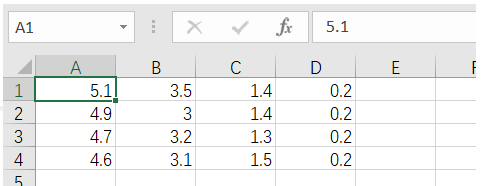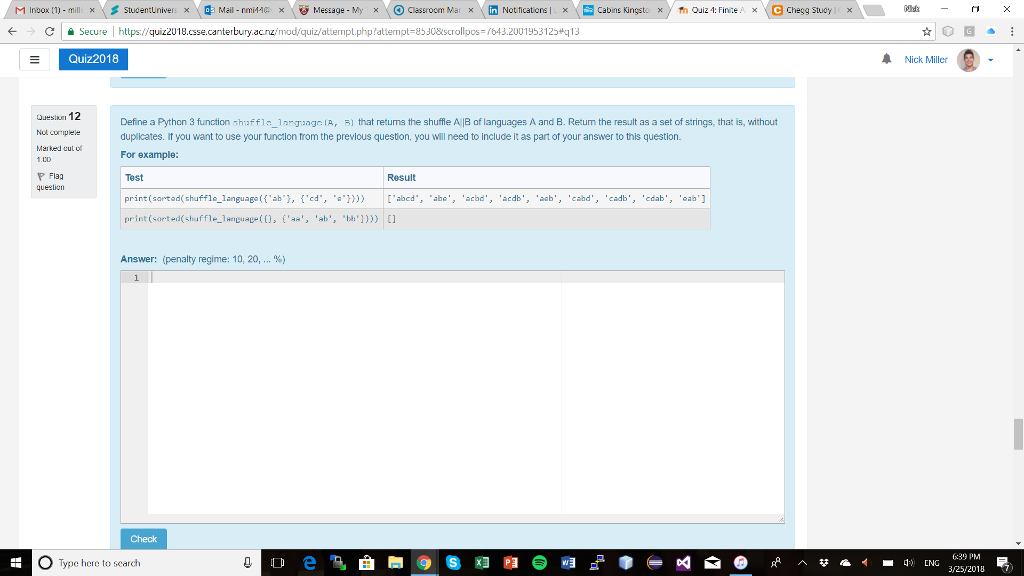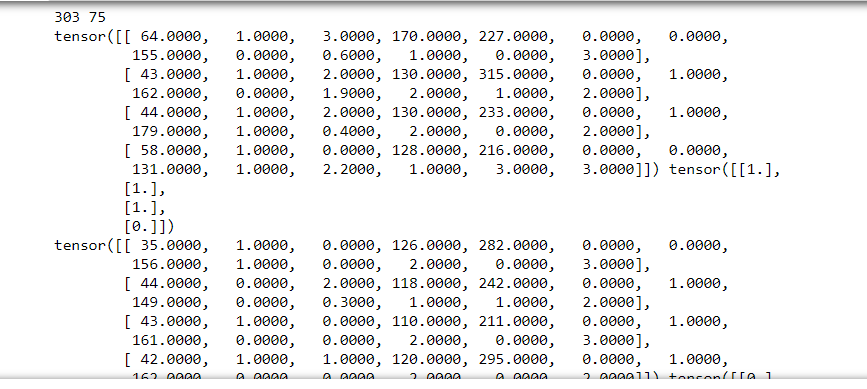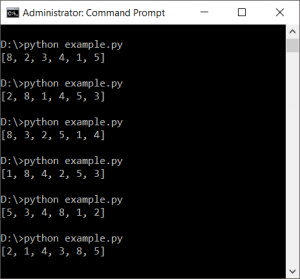44 shuffle data and labels python
sklearn.utils.shuffle — scikit-learn 1.1.1 documentation sklearn.utils.shuffle¶ sklearn.utils. shuffle (* arrays, random_state = None, n_samples = None) [source] ¶ Shuffle arrays or sparse matrices in a consistent way. This is a convenience alias to resample(*arrays, replace=False) to do random permutations of the collections.. Parameters *arrays sequence of indexable data-structures. Indexable data-structures can be arrays, lists, … Sklearn.StratifiedShuffleSplit() function in Python - GeeksforGeeks Step 2) Load the dataset and identify the dependent and independent variables. The dataset can be downloaded from here. Python3 churn_df = pd.read_csv (r"ChurnData.csv") X = churn_df [ ['tenure', 'age', 'address', 'income', 'ed', 'employ', 'equip', 'callcard', 'wireless']] y = churn_df ['churn'].astype ('int') Step 3) Pre-process data. Python3
Python | Ways to shuffle a list - GeeksforGeeks 24.06.2021 · Output: The original list is : [1, 4, 5, 6, 3] The shuffled list is : [4, 3, 1, 5, 6] Method #2 : Using random.shuffle () This is most recommended method to shuffle a list. Python in its random library provides this inbuilt function which in-place shuffles the list. Drawback of this is that list ordering is lost in this process.

Shuffle data and labels python
Python Examples of random.shuffle - ProgramCreek.com This page shows Python examples of random.shuffle. Search by Module; Search by Words; Search Projects; Most Popular. Top Python APIs Popular Projects. Java; Python; JavaScript; TypeScript; C++; Scala; ... imglist=imglist, data_name=data_name, label_name=label_name) if aug_list is None: self.auglist = CreateDetAugmenter(data_shape, **kwargs ... Pandas - How to shuffle a DataFrame rows - GeeksforGeeks 10.07.2020 · Let us see how to shuffle the rows of a DataFrame. We will be using the sample() method of the pandas module to to randomly shuffle DataFrame rows in Pandas.. Algorithm : Import the pandas and numpy modules.; Create a DataFrame. Shuffle the rows of the DataFrame using the sample() method with the parameter frac as 1, it determines what … Python - How to shuffle two related lists (training data and labels ... 21.10.2019 · You can try one of the following two approaches to shuffle both data and labels in the same order. Approach 1: Using the number of elements in your data, generate a random index using function permutation(). Use that random index to shuffle the data and labels. >>> import numpy as np
Shuffle data and labels python. Python | Ways to shuffle a list - GeeksforGeeks Method #1 : Fisher-Yates shuffle Algorithm This is one of the famous algorithms that is mainly employed to shuffle a sequence of numbers in python. This algorithm just takes the higher index value, and swaps it with current value, this process repeats in a loop till end of the list. Python3 import random test_list = [1, 4, 5, 6, 3] How to use random.shuffle() on a generator? python - NewbeDEV Luckily, this is pretty easy in Python: tmp = list (yielding (x)) random.shuffle (tmp) for i in tmp: print i. Note the call to list () which will read all items and put them into a list. If you don't want to or can't store all elements, you will need to change the generator to yield in a random order. Depending on the case, if you know how much ... Python random.shuffle() to Shuffle List, String - PYnative Use the below steps to shuffle a list in Python Create a list Create a list using a list () constructor. For example, list1 = list ( [10, 20, 'a', 'b']) Import random module Use a random module to perform the random generations on a list Use the shuffle () function of a random module Python | Shuffle two lists with same order - GeeksforGeeks Method : Using zip () + shuffle () + * operator In this method, this task is performed in three steps. Firstly, the lists are zipped together using zip (). Next step is to perform shuffle using inbuilt shuffle () and last step is to unzip the lists to separate lists using * operator. import random test_list1 = [6, 4, 8, 9, 10]
Python Shuffle List | Shuffle a Deck of Card - Python Pool The concept of shuffle in Python comes from shuffling deck of cards. Shuffling is a procedure used to randomize a deck of playing cards to provide an element of chance in card games. Shuffling is often followed by a cut, to help ensure that the shuffler has not manipulated the outcome. In Python, the shuffle list is used to get a completely ... How to Shuffle Pandas Dataframe Rows in Python • datagy 29.11.2021 · In this tutorial, you’ll learn how to shuffle a Pandas Dataframe rows using Python.You’ll learn how to shuffle your Pandas Dataframe using Pandas’ sample method, sklearn’s shuffle method, as well as Numpy’s permutation method. You’ll also learn why it’s often a good idea to shuffle your data, as well as how to shuffle your data and be able to recreate … Shuffling multiple lists in Python | Wadie Skaf | Towards Dev Shuffling a list has various uses in programming, particularly in data science, where it is always beneficial to shuffle the training data after each epoch so that the model does not have the data in the same order and hence learn more. In Python, shuffling a list is quite simple: import random l = ['this', 'is', 'an', 'example', 'list] Python Number shuffle() Method - tutorialspoint.com Description. Python number method shuffle() randomizes the items of a list in place.. Syntax. Following is the syntax for shuffle() method −. shuffle (lst ) Note − This function is not accessible directly, so we need to import shuffle module and then we need to call this function using random static object.. Parameters. lst − This could be a list or tuple. ...
Python - How to shuffle two related lists (training data and labels ... You can try one of the following two approaches to shuffle both data and labels in the same order. Approach 1: Using the number of elements in your data, generate a random index using function permutation (). Use that random index to shuffle the data and labels. >>> import numpy as np Splitting Your Dataset with Scitkit-Learn train_test_split January 5, 2022. In this tutorial, you'll learn how to split your Python dataset using Scikit-Learn's train_test_split function. You'll gain a strong understanding of the importance of splitting your data for machine learning to avoid underfitting or overfitting your models. You'll also learn how the function is applied in many machine ... Python | Shuffle two lists with same order - GeeksforGeeks 22.02.2022 · Method : Using zip () + shuffle () + * operator. In this method, this task is performed in three steps. Firstly, the lists are zipped together using zip (). Next step is to perform shuffle using inbuilt shuffle () and last step is to unzip the lists to … Python Random shuffle() Method - W3Schools The shuffle () method takes a sequence, like a list, and reorganize the order of the items. Note: This method changes the original list, it does not return a new list. Syntax random.shuffle ( sequence, function ) Parameter Values More Examples Example You can define your own function to weigh or specify the result.
Shuffle in Python - Javatpoint In this tutorial, we will learn how we can shuffle the elements of a list using Python. The different approaches that we will use to shuffle the elements are as follows- Using Fisher-Yates shuffle algorithm Using shuffle () Using sample () Random selection of elements and then appending them in a list We will discuss each method in detail.
PyTorch DataLoader shuffle - Python I did an experiment and I did not get the result I was expecting. For the first part, I am using. 3. 1. trainloader = torch.utils.data.DataLoader(trainset, batch_size=128, 2. shuffle=False, num_workers=0) 3. I save trainloader.dataset.targets to the variable a, and trainloader.dataset.data to the variable b before training my model.
Shuffle, Split, and Stack NumPy Arrays in Python - Medium If the goal is to return random subsets of an array, another way to accomplish the goal is to first shuffle the array and then sample it. Note that unlike some of the other methods, np.random.shuffle () performs the operation in place. Given the shuffled array, slice and dice it however you want to return subsets.
python - How to shuffle two numpy arrays, so that record indices are ... import numpy as np data = np.random.randn (10, 1, 5, 5) # num_records, depth, height, width labels = np.array ( [1,1,1,1,1,0,0,0,0,0]) I want to shuffle the data and labels by num_records to get labels in a random order. I know that one could use shuffle function: np.random.shuffle (data).
Shuffle an array in Python - GeeksforGeeks 05.09.2021 · Python | Shuffle two lists with same order. 25, Sep 19. random.shuffle() function in Python. 12, May 20. numpy.random ... Shuffle a deck of card with OOPS in Python. 06, Oct 20. Python - Shuffle dictionary Values. 22, Jan 21. Pandas - How to shuffle a DataFrame rows. 06, Jul 20. Shuffle a given Pandas DataFrame rows. 15, Aug 20. How ...
How to Shuffle Pandas Dataframe Rows in Python • datagy # Reproducing a shuffled dataframe in Pandas with random_state= shuffled = df.sample(frac=1, random_state=1).reset_index() print(shuffled.head()) # Returns: # index Name Gender January February # 0 6 Melissa Female 75 100 # 1 2 Kevin Male 75 75 # 2 1 Kate Female 95 95 # 3 0 Nik Male 90 95 # 4 4 Jane Female 60 50

python - Support Vector - / Logistic - regression: do you have benchmark results for the boston ...
Snorkel Python for Labelling Datasets Programmatically - Section Instead of humans labelling large datasets manually, Snorkel assigns labels to the extensive training data automatically. This is done using a set of user rules, labelling functions, and other in-built techniques. Snorkel requires users to come up with functions that contain explicit rules. We will use these rules to label the unlabeled data.
11 Amazing NumPy Shuffle Examples - Like Geeks Let us shuffle a Python list using the np.random.shuffle method. a = [5.4, 10.2, "hello", 9.8, 12, "world"] print (f"a = {a}") np.random.shuffle (a) print (f"shuffle a = {a}") Output: If we want to shuffle a string or a tuple, we can either first convert it to a list, shuffle it and then convert it back to string/tuple;
python - Randomly shuffle data and labels from different files in … 04.04.2017 · Alternatively you can concatenate the data and labels together, shuffle them and then separate them into input x and label y as shown below: def read_data (filename, delimiter, datatype): # Read data from a file return = np.genfromtxt (filename, delimiter, dtype= datatype) classes = read_data ('labels.csv', dtype= np.str , delimiter='\t') data ...
Pandas - How to shuffle a DataFrame rows - GeeksforGeeks Shuffle the rows of the DataFrame using the sample () method with the parameter frac as 1, it determines what fraction of total instances need to be returned. Print the original and the shuffled DataFrames. import pandas as pd import numpy as np ODI_runs = {'name': ['Tendulkar', 'Sangakkara', 'Ponting', 'Jayasurya', 'Jayawardene', 'Kohli',
Shuffle a list, string, tuple in Python (random.shuffle, sample) To randomly shuffle elements of lists (list), strings (str), and tuples (tuple) in Python, use the random module.random — Generate pseudo-random numbers — Python 3.8.1 documentation; random provides shuffle() that shuffles the original list in place, and sample() that returns a new list that is randomly shuffled.sample() can also be used for strings and tuples.
Shuffle an array in Python - GeeksforGeeks Output: Original array: [1 2 3 4 5 6] Shuffled array: [4 5 2 6 1 3] Method 3: In this method we will use sample() method from Random library to shuffle the given array.
Python Random shuffle() Method - W3Schools Definition and Usage. The shuffle () method takes a sequence, like a list, and reorganize the order of the items. Note: This method changes the original list, it does not return a new list.
How to randomly shuffle data and target in python? - Stack Overflow If you're looking for a sync/ unison shuffle you can use the following func. def unisonShuffleDataset (a, b): assert len (a) == len (b) p = np.random.permutation (len (a)) return a [p], b [p] the one above is only for 2 numpy. One can extend to more than 2 by adding the number of input vars on the func. and also on the return of the function.
Pandas Shuffle DataFrame Rows Examples - Spark by {Examples} Use pandas.DataFrame.sample (frac=1) method to shuffle the order of rows. The frac keyword argument specifies the fraction of rows to return in the random sample DataFrame. frac=None just returns 1 random record. frac=.5 returns random 50% of the rows. Note that the sample () method by default returns a new DataFrame after shuffling.
Python: Shuffle a List (Randomize Python List Elements) 11.10.2021 · The random.shuffle () function makes it easy to shuffle a list’s items in Python. Because the function works in-place, we do not need to reassign the list to itself, but it allows us to easily randomize list elements. Let’s take a look at what this looks like: # Shuffle a list using random.shuffle () import random.
python - Loading own train data and labels in dataloader using pytorch ... # create a dataset like the one you describe from sklearn.datasets import make_classification x,y = make_classification () # load necessary pytorch packages from torch.utils.data import dataloader, tensordataset from torch import tensor # create dataset from several tensors with matching first dimension # samples will be drawn from the first …
python - Randomly shuffle data and labels from different files in the ... In other way, how can l shuffle my labels and data in the same order. import numpy as np data=np.genfromtxt ("dataset.csv", delimiter=',') classes=np.genfromtxt ("labels.csv",dtype=np.str , delimiter='\t') x=np.random.shuffle (data) y=x [classes] do this preserves the order of shuffling ? python numpy random shuffle Share
![[LeetCode] 1470. Shuffle the Array (Python)](https://img1.daumcdn.net/thumb/R1280x0/?scode=mtistory2&fname=https:%2F%2Fblog.kakaocdn.net%2Fdn%2FbkOAYj%2FbtqSX7mHc01%2FRWKFvSQTN709qh7sKDGS8K%2Fimg.png)















Post a Comment for "44 shuffle data and labels python"